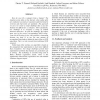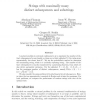123 search results - page 9 / 25 » Derandomizing from Random Strings |
ICDAR
2003
IEEE
14 years 19 days ago
2003
IEEE
How do you tell a computer from a human? The situation arises often on the Internet, when online polls are conducted, accounts are requested, undesired email is received, and chat...
STOC
2005
ACM
14 years 7 months ago
2005
ACM
Our main result is a reduction from worst-case lattice problems such as GAPSVP and SIVP to a certain learning problem. This learning problem is a natural extension of the `learnin...
CRYPTO
2012
Springer
11 years 9 months ago
2012
Springer
It is notoriously difficult to create hardware that is immune from side channel and tampering attacks. A lot of recent literature, therefore, has instead considered algorithmic de...
ALGORITHMICA
2005
13 years 7 months ago
2005
Abstract. We consider random tries and random patricia trees constructed from n independent strings of symbols drawn from any distribution on any discrete space. We show that many ...
COMBINATORICS
2004
13 years 7 months ago
2004
A natural problem in extremal combinatorics is to maximize the number of distinct subsequences for any length-n string over a finite alphabet ; this value grows exponentially, but...


